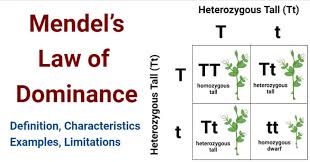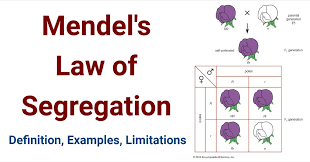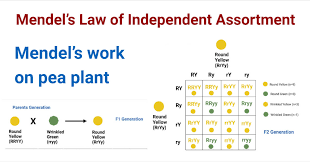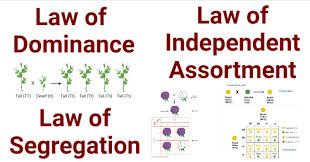Inheritance refers to the transmission of characteristics from one generation to another with minimal changes. This article explores the historical background of inheritance principles and the foundational laws that govern them.
Principles of Inheritance in Agricultural Organisms
Historically, it has been observed that both plants and animals tend to produce offspring resembling themselves. Although this observation was made early on, the underlying mechanisms of inheritance remained unclear until 1866. Various theories emerged over time regarding how traits are passed from parents to offspring.
One such theory suggested that the factors responsible for trait transmission were fluid and blended during reproduction, resulting in offspring with intermediate characteristics. Another belief was that inheritance in animals occurred through the mixing of parental blood.
The philosopher Aristotle proposed a different perspective, asserting that the male and female contributions to offspring were unequal. He believed that the female provided the matter, while the male imparted the form or essence.
Ancient Chinese farmers attempted to improve rice varieties through hybridization and selection, despite lacking knowledge of the underlying inheritance principles. Hybridization involves crossing genetically distinct parents to produce offspring, while selection entails choosing specific individuals from a generation to reproduce based on desired traits.
Significant contributions to the understanding of inheritance were made by scientists such as Knight (1799), Goss (1824), and Mendel (1866).
Knight crossed pea plants with differing traits and observed that the first generation (F1) exhibited only the dominant traits. Upon self-fertilization, the F1 generation produced offspring with both dominant and recessive traits, indicating a pattern of inheritance. He also noted that reciprocal crosses yielded the same results.
Goss, in 1824, reported that crossing green-seeded pea plants with yellow-seeded ones resulted in F1 progeny with yellow seeds. Self-fertilization of these F1 plants produced pods with varying seed colors, demonstrating the segregation of traits.
However, both Knight and Goss did not maintain detailed statistical records, limiting the impact of their findings.
Gregor Mendel, an Augustinian monk, conducted extensive cross-breeding experiments with pea plants over eight years. His meticulous records and analysis led to the formulation of three fundamental laws of inheritance:
- Law of Dominance
- Law of Segregation
- Law of Independent Assortment
Read Also: Various Types Of Fruits And Their Nutritional Value
1. Law of Dominance in Agricultural Genetics

This law states that when two contrasting traits are crossed, one trait (dominant) will mask the expression of the other (recessive). In cases of incomplete dominance, both traits interact, resulting in an intermediate expression.
Mendel observed that crossing red-flowered plants consistently produced red-flowered offspring. However, crossing tall and dwarf plants resulted in all tall offspring in the F1 generation.
Upon self-fertilization, the F1 generation produced both tall and dwarf plants, indicating that the dwarf trait was recessive and unexpressed in the first generation.
2. Law of Segregation and Its Role in Crop and Livestock Breeding

According to this law, each trait is determined by a pair of genes, and only one gene from each pair is passed on to the offspring.
Mendel’s experiments showed that crossing red-flowered plants with white-flowered ones resulted in all red-flowered F1 offspring. Self-fertilization of these F1 plants produced a 3:1 ratio of red to white flowers in the F2 generation.
Further analysis revealed a 1:2:1 genotypic ratio, with one-third true-breeding red, one-third hybrid red, and one-third true-breeding white plants. Similar patterns were observed in experiments with tall and dwarf pea plants.
Read Also: Various Types Of Fruits And Their Nutritional Value
3. Law of Independent Assortment in Agricultural Breeding

This law states that genes for different traits are inherited independently of each other.
Mendel crossed pea plants differing in two traits: seed shape (round vs. wrinkled) and seed color (yellow vs. green). The F1 generation exhibited only round, yellow seeds. Self-fertilization of the F1 plants produced F2 offspring with four phenotypic combinations in a 9:3:3:1 ratio:
- Round yellow
- Round green
- Wrinkled yellow
- Wrinkled green
This demonstrated that the inheritance of one trait did not influence the inheritance of another.
Application of Mendelian Genetics to Animal Improvement
Understanding Mendelian genetics is crucial for selecting specific traits in plants and animals. Each germ cell contains homologous chromosomes with identical genes (alleles) affecting the same trait. If both alleles influence the trait similarly, the individual is homozygous; if differently, heterozygous. A dominant allele masks the effect of a recessive one.
For example, in cattle, the polled (hornless) trait is dominant over the horned trait. Mating homozygous polled (HH) with homozygous horned (hh) cattle results in heterozygous (Hh) polled offspring. Interbreeding these heterozygous cattle yields a 3:1 ratio of polled to horned animals.
In cases of incomplete dominance, such as coat color in shorthorn cattle, crossing red-coated (RR) with white-coated (rr) individuals produces roan-coated (Rr) offspring. Interbreeding roan cattle results in a 1:2:1 ratio of red, roan, and white-coated offspring.
The law of independent assortment can be illustrated by considering two traits simultaneously, such as polledness and dwarfism in Hereford cattle. Crossing homozygous polled, non-dwarf (HHDD) with homozygous horned, dwarf.
Do you have any questions, suggestions, or contributions? If so, please feel free to use the comment box below to share your thoughts. We also encourage you to kindly share this information with others who might benefit from it. Since we can’t reach everyone at once, we truly appreciate your help in spreading the word. Thank you so much for your support and for sharing!

